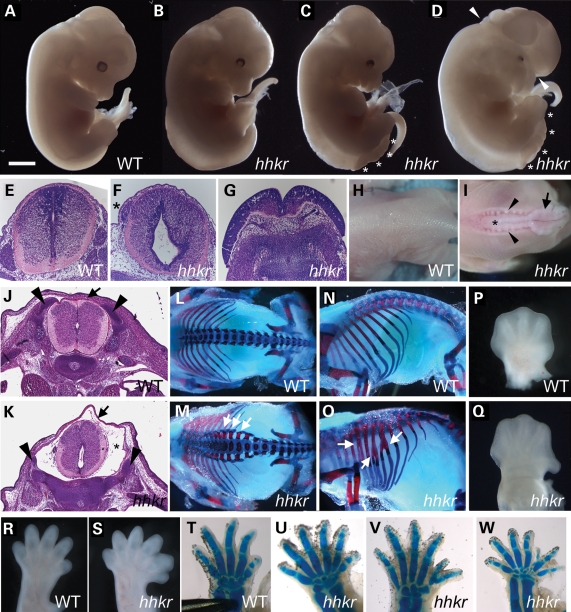Figure 1.
hitchhiker mutant mouse embryos exhibit defects in neural tube, skeleton and limb development. (A–D) E13.5 wild-type (A) and hitchhiker embryos (B–D) with a range of phenotypes, including oedema (B), oedema with spina bifida (C) and oedema with spina bifida and exencephaly (D). Asterisks mark region with spina bifida and exencephalic region is marked with arrowheads. (E–G) Transverse sections stained with haematoxylin and eosin (H&E) through spinal neural tissue in wild-type (E), mutant with caudal oedema and dorsally positioned dorsal root ganglia (asterisk) (F) and mutant with spina bifida (G). (H and I) Dorsal views of E18.5 wild-type (H) and hitchhiker mutant (I) fetuses demonstrating splayed vertebrae (arrowheads) and visible neural tube (asterisk) adjacent to a region of open spina bifida (arrow) in mutants. (J and K) H&E-stained sections through the thoracolumbar region of E15.5 wild-type (J) and hitchhiker (K) fetuses. The mutant exhibited the splayed vertebrae phenotype, and sections demonstrate a closed but abnormally shaped neural tube within a grossly enlarged spinal canal (asterisk), covered dorsally with a thin layer of surface ectoderm (arrow) and flanked by widely spaced vertebral primordia (arrowheads), compared with wild-type. (L–O) Skeletal preparations of E18.5 wild-type (L and N) and hitchhiker mutant (M and O) fetuses stained with alcian blue for cartilage and alizarin red for bone, demonstrating splayed vertebrae (M; arrows) and rib bifurcations (O; arrows) in mutants. (P and Q) Forelimbs from wild-type (P) and hitchhiker mutants (Q) at E13.5, demonstrating malposition of digit 1 in mutants. (R and S) E15.5 wild-type (R) and hitchhiker (S) limb buds showing preaxial polydactyly with six digits. (T–W) E16.5 skeletal preparations for wild-type forelimb (T) and hitchhiker mutants (U–W) demonstrating preaxial polydactyly with a range of phenotypes. Limbs are oriented with anterior to right. Scale bars: A–D and H: 2.5 mm; E–G: 0.5 mm; H and I: 5 mm; J and K: 1 mm; L–O: 4 mm; P and Q: 1 mm; R and S: 1.1 mm; T–W: 1.2 mm.

